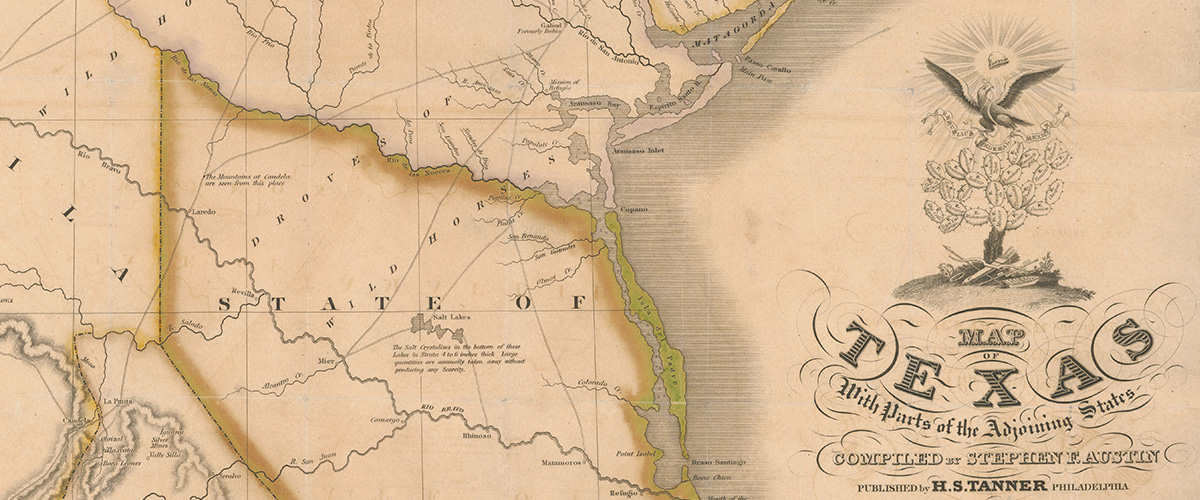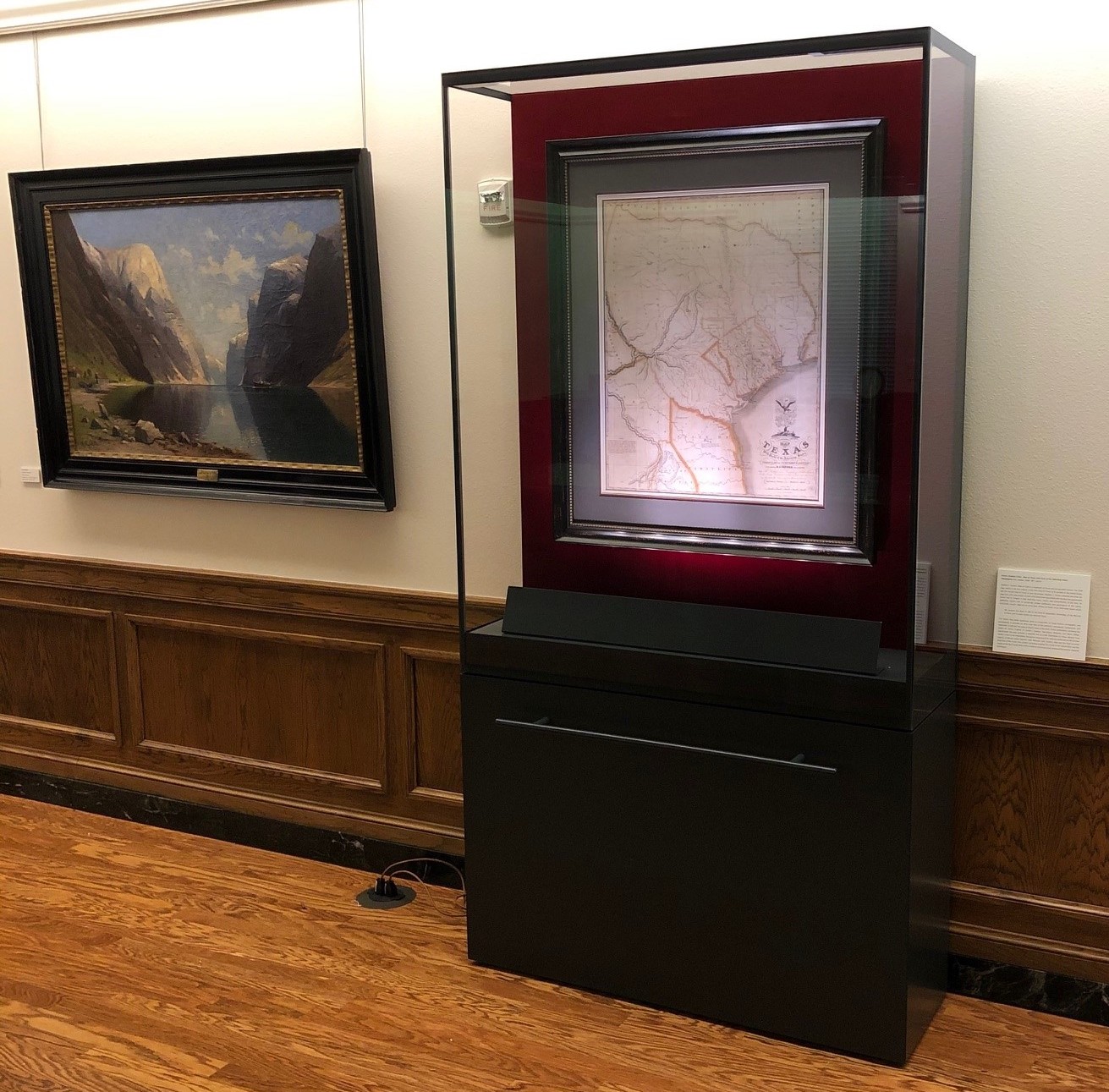Making a Case for Texas History
By Francesca Marini and Leslie J. Winter | 06-02-2021
An Interview with Ian Muise, Anton duPlessis and Sierra Laddusaw

The 1830 Stephen F. Austin Map of Texas. Detail.
In April 2021, a new, special exhibition case was installed at the Cushing Memorial Library and Archives to house an original copy of the rare 1830 Stephen F. Austin Map of Texas. Only ten of these maps are left in existence! Preservation Librarian Ian Muise and Curators Sierra Laddusaw and Anton duPlessis discuss commissioning and designing this amazing display case.
How did this project start? What is housed in this special exhibition case and why is the item significant?
Ian Muise: In April 2018, a first edition of the 1830 Stephen F. Austin Map of Texas was acquired by the Texas A&M University Libraries, Cushing Memorial Library and Archives, with funding from The Texas A&M University System Chancellor, the Board of Regents and Bonnie and Otway Denny ’71. Drawn by Stephen F. Austin, this is the second map of Texas to ever be printed, and the first to be printed in the United States.
Sierra Laddusaw: Austin’s Map is often referred to as the “Birth Certificate of Texas”. Creating the map was a requirement by agreement with the Mexican government and it took Austin five years to compile the information and then draw the map.

Anton duPlessis: The map is often called the “Birth Certificate of Texas,” but it conveys a larger story of failed imperial ambitions that created the space for the Republic in 1836. Spain was faced with the conundrum to reconcile the anxiety of maintaining its tenuous presence in North America, in light of the competition with other European powers and the Bourbon Reforms to develop and colonize areas like Texas. In the early 1800s, Spain decided to encourage immigration by authorizing empresarios like Moses Austin to recruit settlers to Texas. Following its independence, but facing the same need to develop Texas, Mexico deliberated whether to continue this policy. Stephen F. Austin retained his father’s status as an empresario and this map was Austin’s effort to comply with his contract with the Mexican government and encourage the settlement of his and Green DeWitt’s land grants in Texas. An interesting aspect of the map, is the credit given to General Terán, showing the collaboration it took to produce such an accurate and detailed map.
Ian Muise: With such a valuable acquisition, we wanted to make sure that it received the best possible care and housing, but we also wanted it to be displayed prominently for visitors and scholars. To achieve this goal, we realized we would need a high-quality display case.
What is special about this case? How did you pick the manufacturer?
Ian Muise: Thanks to funding from the Eugene Edge, III Charitable Trust, we had the resources to seek out the best case available to house and display the map. We followed the display case design guidelines published by the American Institute of Conservators (AIC) for producing a conservation-grade case that provides all-around protection (https://www.conservation-wiki.com/wiki/Category:Exhibit_Case_Design). We began looking for a manufacturer who could produce a custom case that would meet these guidelines.
Goppion S.p.A. of Milan, Italy was very responsive to our inquiries and provided informative literature about their case construction and technology. They also have an impressive track record of providing display cases to distinguished museums around the world for high-profile collections. Goppion has provided cases to display the British crown jewels in the Tower of London and the Mona Lisa in the Louvre, for example.
Initially, we planned to mount the case to the wall, and our early design selections were focused on this approach. Due to the historic nature of the building, we conducted research in the Cushing archives to determine the structural components of the building. As we worked with Goppion’s engineers, concerns were raised about the structural implications of suspending a heavy case from the extruded clay tile blocks that make up the walls of Cushing Library. We came to the conclusion that a free-standing case would be the best approach. Our case features several high-tech, unique and/or patented features that provide the highest level of artifact protection and will mitigate threats of vandalism, inadvertent damage, theft, and deterioration caused by environmental hazards. Included among the case features are a top buckling prevention system, and sheet glass jointed along milled interlocking edges to increase strength. The case also uses extra-clear non-reflective glass for ultraviolet light exclusion, an airtight system with magnetic gasket seals that only allows one complete air exchange every 20 days, a built-in LED lighting system, a passive climate control system that uses a fan-circulated silica-gel compartment, and a built-in temperature and humidity datalogger. The case is Oddy Test compliant, ensuring that the materials used in the construction of the case do not off-gas or emit chemicals or fumes that could damage the map.
Who was involved in this project?

Ian Muise: This project represents a team effort. Julie Mosbo-Ballestro provided a great deal of input and guidance as both Director of Preservation and Interim Director of Cushing Memorial Library and Archives during the initial design and selection process. Members of the Preservation Unit also contributed significantly: Jeanne Goodman reviewed the proposed case materials and coatings as conservator; Madi Byerly assisted with early research on case manufacturers; and Robin Hutchison reviewed the design and provided important information about the construction of Cushing Memorial Library and Archives to inform our case selection. Additionally, we received indispensable feedback from Curators Sierra Laddusaw and Anton duPlessis, and Programming and Outreach Librarian Dr. Francesca Marini. Beth Kilmarx, Associate Dean for Special Collections and current Director of the Cushing Library, was extremely supportive, and we received great help from staff members Melissa Zajicek and Wendy Mackey. Russell Reid from the College of Architecture provided consultation about color and fabric selection. Bruno Goppion, our manufacturer contact, was terrific to work with during the whole process, as was Ted Paschkis, their installer. Finally, Keith Henderson from the Libraries Facilities team was essential to coordinating and executing the final move of the case safely into Cushing.
What about this project makes you most proud?
Ian Muise: I am most proud of the outstanding collaborative effort that led to the design, construction, and installation of the case. During a span of time that was significantly impacted by the COVID-19 pandemic, a team of people with broad expertise from across the Libraries, University, and industry came together to produce a very successful outcome.
Sierra Laddusaw: I am proud of and excited about the opportunity to display a special piece in our collection in a more permanent fashion. Adding the Austin map to the collection was a huge moment: it highlighted our former students and Board of Regents’ commitment to building our special collections and, as curator of maps, was at the top of my wish list of cartographic objects to make available to students and researchers! Being able to have the map out for anyone to come in and see is what we are all about at Cushing!
Anton duPlessis: I’m proud that Austin’s map, of which there are few, will be able to be seen by anyone when they visit Cushing. It took the insights and efforts of many to bring the case to fruition and clearly shows what can be done when we collaborate.
Is there anything else you would like to add?
Ian Muise: I just want to thank everyone who helped with this project for their input, efforts, and patience. The result is exactly what we had hoped for when we began this process: an extremely well-crafted display case that will house, protect, and exhibit the 1830 Stephen F. Austin Map of Texas in the best possible preservation conditions, so that it may be viewed and enjoyed by visitors and researchers to Cushing Memorial Library and Archives for many years to come.
Visitors can view the Austin map and the new exhibition case in the Mayo-Thomas Room of the Cushing Memorial Library and Archives, Monday through Friday, 8am–4:30pm or online at:
Tags: Maps; Steven F. Austin; Texas; Conservation; Exhibition Case; Permanent Exhibition; Preservation; Goppion S.p.A.; Board of Regents (TAMU); Bonnie and Otway Denny ’71; Eugene Edge, III Charitable Trust; Former Students (TAMU); The Texas A&M University System Chancellor.
Cushing Memorial Library and Archives Collections: Floyd & Louise Chapman Texas & Borderlands Collection.
Contact Us: cushingcollective@library.tamu.edu
 |
Ian Muise is the Preservation Librarian at Texas A&M University Libraries. In his role, he works to ensure the preservation of items in the Libraries’ general and special collections, manages environmental monitoring and integrated pest management programs, and participates in disaster planning. He holds a Bachelor’s degree in Construction Science (Texas A&M), a Master’s degree in Public History (NCSU), and a Master of Library Science degree (Texas Woman’s University). |
|
Anton duPlessis, CA, is Clinical Associate Professor at Texas A&M University Libraries, Cushing Memorial Library & Archives where he is curator of several collections, including Colonial Mexico, Military, and Chapman Texas & Borderlands. In addition, he is director of the Primeros libros de las Américas Project, a long running international digital project for 16th Century novohispano imprints. |
|
 |
Sierra Laddusaw is an Assistant Professor at the University Libraries. She is the Curator of Maps, Co-curator of the Chapman Texas & Borderlands Collection, Curator of Digital Scholarship, and Curator of the Maritime Collection at Cushing Memorial Library & Archives. Her research interests lie in mapping of ideas and imaginary places and the use of cartographic resources in non-traditional fields of study. She has curated a collection at the University Libraries of materials that blur the line between cartography and art. Sierra earned her Master of Library Science from Texas Woman’s University. |
  |
Dr. Francesca Marini, Associate Professor, Programming and Outreach Librarian and Leslie J. Winter, Assistant Professor, Special Collections Public Services Coordinator (TAMU Cushing Memorial Library and Archives) are the editors of The Cushing Collective. |